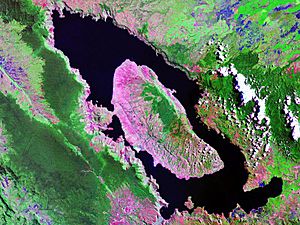Toba catastrophe facts for kids
The Toba catastrophe was the biggest volcanic eruption in the last 2.6 million years! It's called a catastrophe because it was so huge that it might have caused big problems for early humans.
Contents
What Was the Toba Eruption?
The Toba eruption happened about 73,000 years ago in a place called Lake Toba in Sumatra, Indonesia. This was not just any eruption; it was from a supervolcano. A supervolcano is a volcano that can cause a lot of damage to the Earth's climate.
How Big Was This Eruption?
This eruption was incredibly powerful. Scientists measure volcanic eruptions using something called the Volcanic Explosivity Index (VEI). The Toba eruption had a VEI of 8, which is the highest possible! People describe it as "apocalyptic" because of its massive size.
To give you an idea, this eruption was 100 times bigger than the largest known eruption in recent history. That was the 1815 eruption of Mount Tambora, also in Indonesia. The Tambora eruption caused a "Year Without a Summer" in 1816 in many parts of the world. Imagine how much bigger Toba was!
The Toba eruption created a giant bowl-shaped area called a caldera, which is now Lake Toba. This lake is huge, about 100 kilometers (62 miles) long and 30 kilometers (19 miles) wide.
What Happened After the Eruption?
When Toba erupted, it threw out a massive amount of ash and gas into the atmosphere. This caused a "volcanic winter" around the world.
How Did It Change the Climate?
The volcanic winter meant that temperatures dropped significantly. Globally, temperatures fell by about 3 to 5 degrees Celsius (5 to 9 degrees Fahrenheit). In some colder places, the temperature drop was even more extreme, up to 15 degrees Celsius (27 degrees Fahrenheit)! This would have made life very difficult for plants, animals, and humans.
Did It Affect Early Humans?
There's a famous idea called the Toba catastrophe theory. This theory suggests that the eruption had a huge impact on early humans. Some scientists believe it might have killed most of the humans alive at that time.
According to this theory, only a very small number of humans survived, maybe as few as 1,000 to 10,000 pairs. This small group of survivors would have created a "population bottleneck". This means that all humans alive today might have come from this small group, which would affect our genetic inheritance.
The theory also suggests that the eruption might have caused other early human-like species, called hominids, to become extinct. However, we know that Neanderthals, another type of hominid, definitely survived in Europe and Asia.
Is the Theory True?
It's important to know that there is no direct proof that the Toba catastrophe theory is completely correct. Scientists haven't found strong evidence that other animals suffered a big decline or became extinct after the eruption, even species that are very sensitive to environmental changes.
Also, some evidence suggests that humans continued to live in places like India even after the eruption. So, while the Toba eruption was definitely a massive event, the idea that it almost wiped out humanity is still being debated by scientists.
See also
 In Spanish: Teoría de la catástrofe de Toba para niños
In Spanish: Teoría de la catástrofe de Toba para niños



